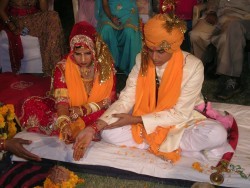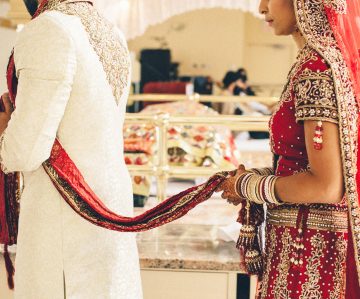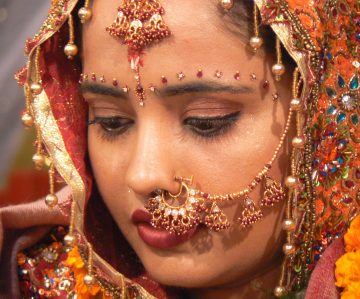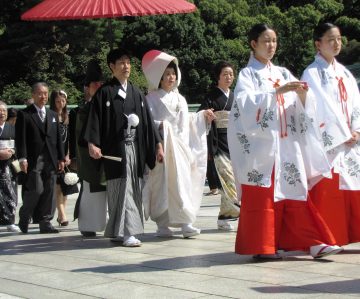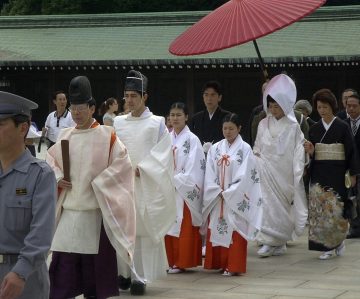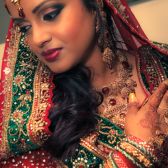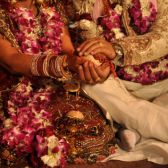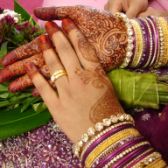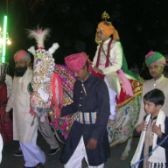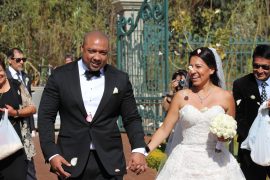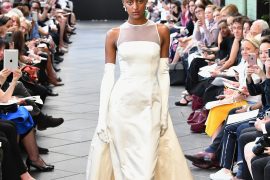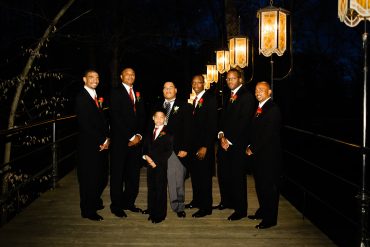There are many different aspects to traditional Asian weddings, but not all of the customs are maintained today as western influences are either replacing or complementing these ancient practices. Traditions vary in different parts of each Asian country and their own set of incredibly diverse social customs and traditions and in many cultures there are many variations on choosing the wedding day in order to ensure a happy and prosperous marriage, the couple should marry at an auspicious time and date. This tradition is not taken lightly and astrologers may be consulted to see if the stars are compatible. Wedding customs in Asian countries are distinct and often extremely beautiful. Join us as we explore some of these age old traditions:
Japan
While the white weddings gown is becoming increasingly popular, one-third of Japanese women still lean towards a traditional pure white kimono (Shiro-Muku) for the formal ceremony, symbolizing purity and maidenhood. Japanese women generally prefer beautifully colored silk kimonos with rich embellishments that are often embroidered with purple iris flowers because in Japan the color purple represents love. The wedding ceremony itself is traditionally either Shinto or Buddhist. During a Shinto ceremony the earth’s natural spirits are asked to bless the newlyweds. Japanese wedding rituals often incorporate items with strong symbolic meaning, its strength or simple elegance; as an example bamboo which represents both prosperity and purity, while the mizuhiki knot given at Japanese weddings is often shaped like a crane, symbolizing prosperity and a long life. It is also traditional to fold 1,000 gold origami cranes since they mate for life and represent good fortune, longevity, and peace in the marriage. During a Buddhist ceremony two strings of beautiful beads are woven together to symbolize the union of two into one. One of our favorite parts is called “Sankon-no-gi” – where the bride and groom drink sake, three times each, from three different cups that are called “sakazuki” they Exchange cups representing the exchange of marriage vows. Next their parents also take sips, sealing the bond between the two families. “Each person takes three sips of sake from each of three cups. The first three sips represent the three couples; the second three sips represent the flaws of hatred, passion, and ignorance; and the last three sips represent freedom from the three flaws.”
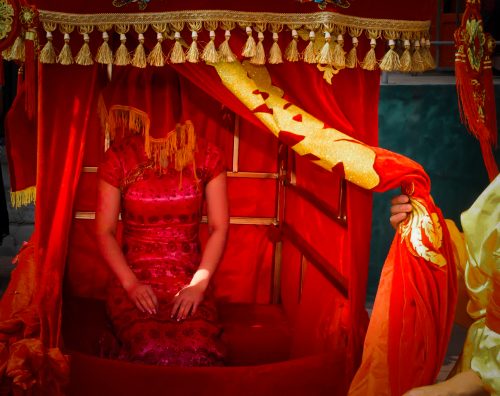
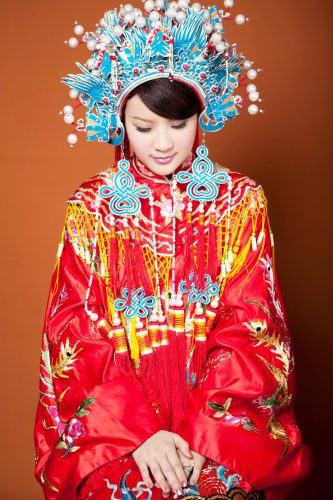
China
Since the ancient times of the Qin (221 BC – 206 BC) and Qing (1644 – 1911) Qing dynasty marriages were considered one of the most important traditions in life. During this period: for the male side, it determined the prosperity and even the future fame of their family; while for the female side, it meant that parents would now give their daughters hand in marriage and she leaves their home to join him so choosing an ideal partner was vital for both the individual and the family.
Chinese wedding gowns are typically red. In Chinese culture this color signifies luck, prosperity, love, and joy, hence the red color scheme is carried throughout traditional Chinese weddings.
Popular choices are Qi Pao is a one-piece garment that is the popular choice for younger Chinese brides as well as traditional wedding dresses which include a two-piece dress called Gua, Kwa or the Chengsam. These dresses are mostly prominent with brides from the southern regions of China. Her dress is usually covered with golden embroideries of peonies, dragons, phoenixes, and chrysanthemums, representing good fortune. The Dragon is the symbol of power and is worshiped by the Chinese since ancient times. The combination of dragon and phoenix symbolizes the balance of male and female power. Most of such traditional dress designs are believed to be inherited from the time of Qing dynasty which was the last dynasty of China.
Traditionally, the family of the groom gives the family of the bride a whole pig, roasted, as a gift upon the couple’s engagement. During both the ceremony and reception you’ll hear quite a number of firecrackers which are used to scare the evil spirits away.
Korea
In Korea, the pre-wedding traditions are just as important as the wedding itself. It is customary for a kung-hap or a fortune teller to visit the couple and look into their future. The kung-hap is looking to determine whether or not the newlyweds will live a harmonious life together. If it is determined that they will not live harmoniously the wedding never takes place. For over 2,000 years, the traditional Korean costume, the Hanbok, has been worn by men, women and children. Originally, the Hanbok was made out of white cotton, silk or hemp. Today Koreans wear Hanboks in many colors and types of fabrics. The women’s attire includes a Chogori (short jacket with long sleeves) with 2 long ribbons which are tied to form the otkorum. A chima, a full length, high waisted wrap around skirt is worn. Boat shaped shoes made of silk, are worn with white cotton socks
The bride’s attire might include a white sash with significant symbols or flowers. A headpiece or crown may also be worn. They also decorate with the noriage s a hanbok decoration which has been worn by all classes of Korean women for centuries. It is tied to the skirt or the ribbon on the jacket. The knot on the top is called the Maedup.
An age old tradition is the Jeon-an-rye presentation where the Groom places a wild goose on a table bowing twice to his mother-in-law, who takes the wild goose into the house. The wild goose symbolizes harmony and love between husband and wife. As is tradition Wild geese (it’s actually mandarin duck, to be exact) mate for life: they keep their promises of love and never find another, if they lose their partner. In modern times a wooden goose is substituted.
India
Indian weddings are traditionally multi-day affairs, with intricate ceremonies. Wedding Traditions in India vary across religion, caste, ethnicity, language, region, etc. Traditional Hindu and Sikh weddings are generally structured into pre-wedding day ceremonies. The bride often wears a red and gold or vividly colored lehenga ensemble adorned with rich gold and kundan jewelry. Bengali brides wear beautiful traditional benaroshi and mukut garments. Muslim brides generally wear a golden lehenga studded with emeralds, rubies and other bold colored stones. South Indian brides are known to wear gorgeous Kanjeevaram saris. Whatever their choice it is always an awe inspiring burst of vivid colors and opulence.
Three favorite traditions are the Mehndi ritual, the Baraat and the Mangal Phere (Circling the Sacred Fire) The Mehndi event is colorful and fun held the night before the wedding, which is traditionally celebrated by the women on the bride’s side of the family. Generally, a mehndi artist or relative will apply henna in intricate designs to the hands and feet of the bride and other women in the family. These intricate designs symbolize joy, beauty, spiritual awakening and offering.
The Baraat – on their wedding day, the groom arrives to the ceremony on a decorated white horse. Guests gather and dance around him to the beat of an Indian drum called the “dhol”. Following the procession, the bride and her family greet the groom, and the couple exchanges floral garlands to wear around their necks to symbolize their acceptance of each other. Baraats are welcomed at the wedding venue with the sound of shehnais, which are considered auspicious at weddings by Hindus, Muslims and Sikhs alike.
Another favorite custom is the Mangal Phere (Circling the Sacred Fire): The bride and groom walk around the sacred fire seven times keeping in mind the four aspirations in life: Dharma (duty to each other, family and God), Artha (prosperity), Karma (energy and passion) and Moksha (salvation). The bride, representing divine energy, leads the groom in the first three rounds, while the groom leads in the last four rounds, signifying balance and completeness. In some cultures, the bride and groom walk around the fire four times, with the bride leading in the first three rounds, and the groom leading in the final round. The bride’s brother places rice grains in her hands after she completes each round to signify his pledge to always support and protect her in times of need. Once the couple has completed the four rounds, there’s a race to see who will sit down first. It is said that whoever sits down first will rule the house.
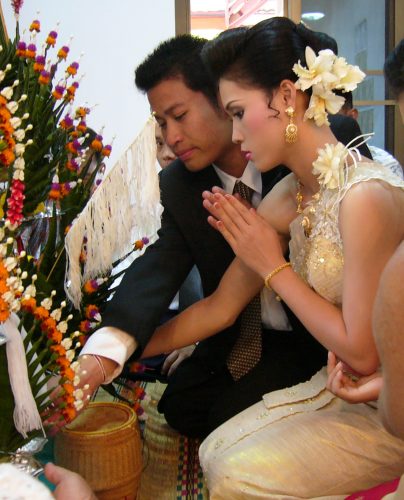
Thailand
The formal Thai national costume, known in Thai as “Chut Thai phra ratcha niyom”, literally Thai dress of royal endorsement, includes several sets of clothing designed for use as national costume in formal occasions such as a wedding. Often gold and silver threads will be used as the weft, making silk produced this way particularly expensive. The Pha-Sin ( Pha-Noong or skirt) is a full length wrap-around skirt with two pleated folds in the front called ‘Na-Nang’.
Before a Thai wedding; the bride and groom are required to prepare a meal for the local monks. The actual wedding ceremony takes place early in the morning at around 6am. Nine monks are invited to bless the couple. A string forming a circle binds the couple. After the monks’ prayers are over, the couple gives the monks each an envelope containing money. The newlyweds then eat lunch with the monks, concluding the morning ceremony, and make a donation to the local wat (temple) for the wedding blessing.
The main event of the wedding ceremony, called rod nam sang, is held in the afternoon. A flower chain connects the hands of the bride and groom as they are held in a wai (Thai symbol of respect). Usually the most senior and respected member of the group officiates this event. The couple’s hands are soaked in the conch shell containing water, followed by wishes of good luck. The parents, close friends, as well as other selected guests will also proceed to follow and soak the newlyweds’ hands. After the meal the monks give the couple their blessing and they can then go forward with their ceremony. During the ceremony you won’t find hundreds of guests – often only the closest relatives and friends. The bride and groom each sit with their hands folded and linked together with a chain of flowers. The ceremony is led by the oldest member of the family who will dip their hands into a shell full of water to symbolize luck. After he has completed this blessing the rest of the guests will do the same thing.
The life of a married couple symbolizes a new beginning. They leave their past behind and start a new life – together. While each country has its own special traditions, each still celebrates the beauty of marriage and, most important, love.

